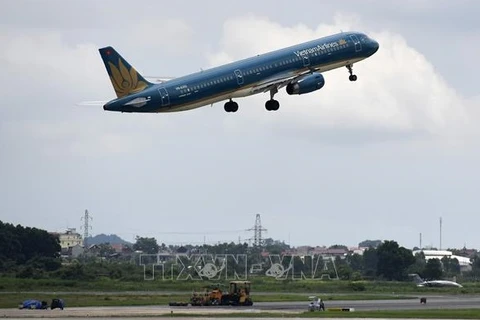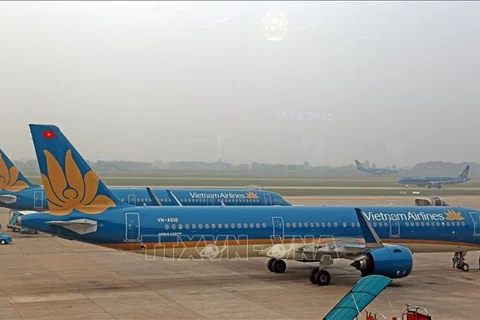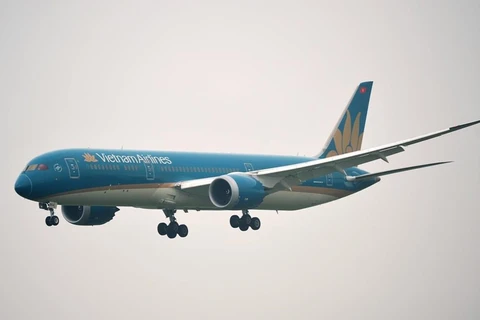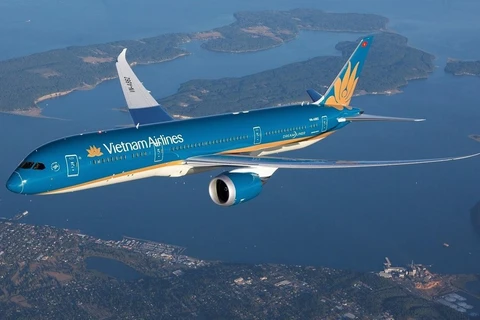Hanoi (VNA) - The national flag carrier Vietnam Airlines announced it has resumed regular passenger service activities to/from 12 countries and territories.
Vietnam Airlines just conducted the first two flights, officially resuming regular commercial flights between Europe and Vietnam following the two years of hiatus as a result of the COVID-19 pandemic.
Flight VN36 from Frankfurt in Germany to Hanoi, Vietnam carried 190 passengers on board, while Flight VN18 from London to Paris and Hanoi, with nearly 300 passengers on board, safely landed at Noi Bai International Airport at 9:30 and 9:55, respectively, on January 26.
The resumption of international commercial air routes by Vietnam Airlines in recent days marks a period of reopening for regular international aviation, restoring links between Vietnam and the rest of the world and ushering in the prospect of a strong recovery after the pandemic, helping develop the economy and boosting investment, tourism, production and business activities.
By now, Vietnam Airlines has restored regular passenger transportation activities to/from 12 countries and territories, namely the US, Japan, Republic of Korea, Singapore, Thailand, Cambodia, Taiwan (China), Australia, Russia and, most recently, the UK, France and Germany.
With the re-opening of regular commercial air routes, Vietnamese communities living, working and studying in, as well as tourists from Europe, now have the agency to schedule their travel and can buy air tickets directly on the website of the national flag carrier and its authorised agents with ease, according to a representative of Vietnam Airlines.
As well as ensuring passengers meet the regulations of having a negative COVID test result and being vaccinated against the virus, or recovering from the pandemic before their departure, Vietnam Airlines will continue to apply preventive measures to flights such as spraying the aircraft with anti-virus chemicals and simplifying the services to limit repeated contacts.
Passengers will have to monitor their health and quarantine themselves following the regulations issued by the Ministry of Health after their arrival.
From February 8, the flight schedules to Europe, namely to the UK, France and Germany, will be conducted on a fixed basis along two air routes. The first will be conducted starting every Tuesday, with the itinerary of Hanoi to London, Frankfurt and then back to Hanoi, while the second will start from Thursday every week with the itinerary of Hanoi to Paris, Frankfurt and then back to Hanoi.
Vietnam Airlines will conduct all of its flights between Vietnam and Europe with large-body planes, namely Boeing 787 and Airbus 350, so that passengers can have the most comfortable experience during the long-haul flights.
The national flag carrier reminds passengers to obtain sufficient information and to ensure that they understand and strictly observe all the regulations on entry, such as the requirements for medical declarations, COVID-19 tests, vaccination status or their recovery from the pandemic, their accommodation at their arrival, and their health monitoring time.
In order to support the passengers with checking this information, Vietnam Airlines will continuously update their website www.vietnamairlines.com, under the column on travel advice/Must-know regulations.
The airline was founded in 1956 and later established as a state-owned enterprise in April 1989.
Vietnam Airlines became a member of Sky Team in June 2010, making it the first Southeast Asian carrier to have joined that alliance, connecting nearly 1,100 destinations all over the world, with international four-star services.
As passenger transport constitutes its core activity, Vietnam Airlines plays a crucial role in the economic development of the country.
The carrier's fleet has been continuously upgraded and includes Airbus A350, Boeing 787 and A321neo aircraft with new generation engines, helping to reduce 50 percent of emissions, 16 percent of fuel and 75 percent of noise compared to older generations./.
























